|
Students who do not feel at ease with the basics of double entry
accounting are strongly advised to go over this example, and work out by
themselves all the calculations.
Consider a newly created firm.
It is possible to compute a Balance Sheet (BS) at any date t,
and an Income Statement between any two dates t1 and t2.
In the example below, we shall always compute the Income Statement from the beginnning of the firm. Let's see this with the following initial transactions of a new firm.
Here is the journal of the first eight transactions :
- Initial founding capital 100 000 euros paid in cash (100 shares of stock, each with a face value of 1000 euros)
- Purchase of goods for 30 000 euros from Mary, on credit
- Sale of half of our stock for cash, for 50 000 euros
- Pay Mary
- Acquisition of equipment (cash) 50 000 euros
- Sale of the remainder of our stock for 40 000 euros to Steve, and we grant
him a credit.
- Purchase of goods for 50 000 euros
- Payment of salary 10 000 euros
Example of Oct 27, 2009 (1)
Example of Oct 27, 2009 (2)
Transaction 1 : Initial founding capital 100 000 euros paid in cash
- Posting of the transaction : credit the Capital account 100 (all
figures are
in thousands of euros) and debit the Cash account 100
- After this transaction, we can establish a BS : assets 100 in cash,
liabilities 100 in the Capital account
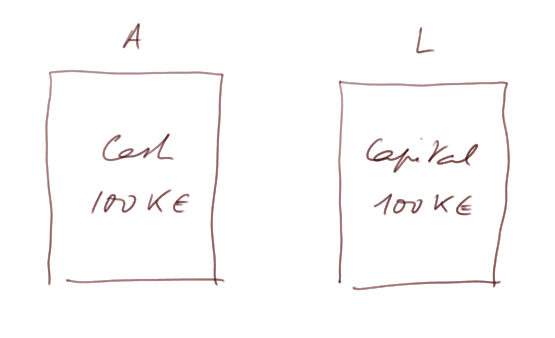
- There is no meaningful IS yet
Transaction 2 : Purchase of goods for 30 000 euros from Mary, on credit.
- Posting : debit the Purchases account 30, and credit the Supplier account
(Mary) 30
- IS : there is still no meaningful IS yet, although we could list this :
- Sales (credit) : 0
- Opening stocks (debit) : 0
- Purchases (debit) : 30
- Closing stocks reported in the IS (credit) : 30
- P&L : 0
- BS :
- Assets :
- Closing stocks reported in the BS (debit) : 30
- Cash (debit) : 100
- Liabilities :
- Capital (credit) : 100
- Trade debt to Mary (credit) : 30
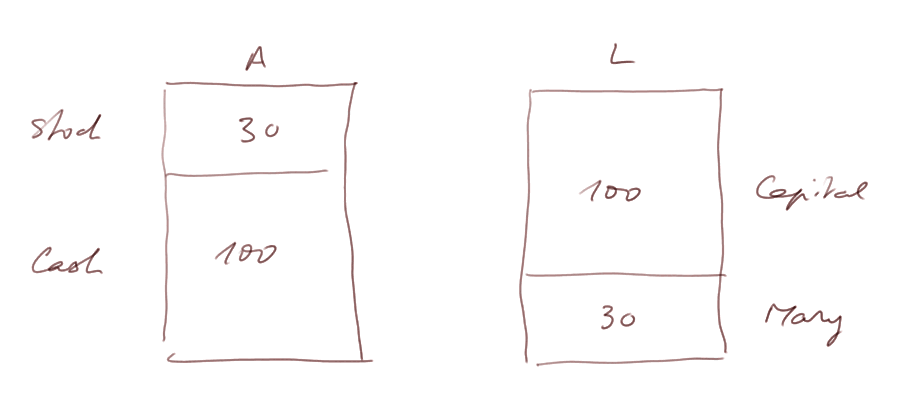
Transaction 3 : Sale of half of our stock for cash, for 50 000 euros
- Posting : credit the Sales account 50, debit the Cash account 50
- IS (from the beginning of the firm until now) : to prepare an IS we must "do an
inventory", i.e. observe that our closing stock now is 15
- Sales (credit) : 50
- Op stock (debit) : 0
- Purchases (debit) : 30
- Closing stock (credit) : 15
- Gross margin : 35 (on the credit side)
- P& L : same thing
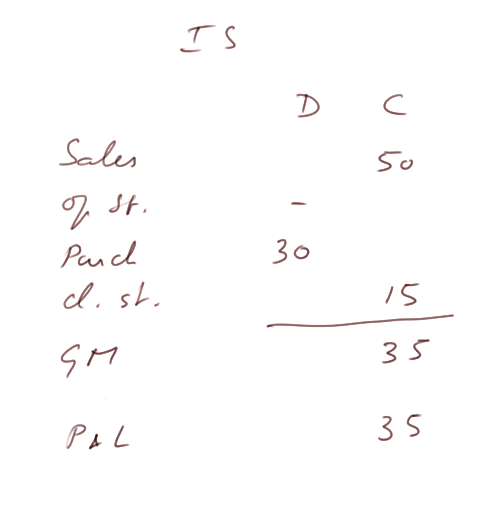
- BS
- Assets :
- Closing stocks : 15
- Cash : 150
- Liabilities :
- Capital 100 (credit)
- Cumulated past retained earnings : 35 (credit, i.e. profit)
- Suppliers : 30
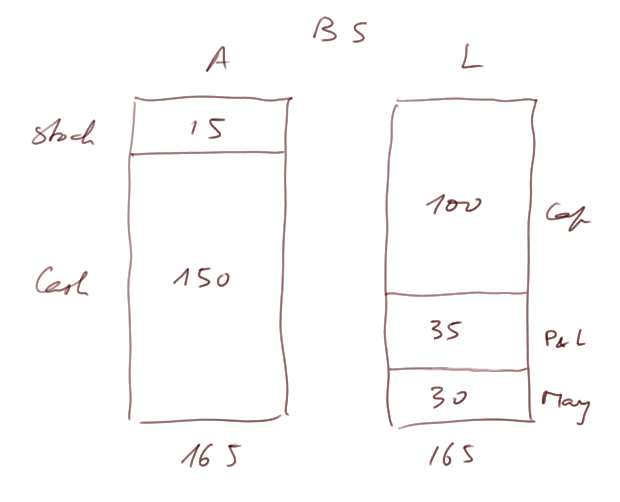
- Note that here we finally reached the gist of business : we created
value by selling for 50, something that we acquired for 15. You may think "well,
that's an easily produced value", but that would be a mistake. Shops do work and add value, and do take risks. They select products ; they purchase
them, bring them and display them in a location convenient for clients. And if
clients don't purchase the products the shop takes the loss.
Transaction 4 : Pay Mary
- Posting : credit the Cash account 30, debit the Suppliers account (Mary)
30
- IS : same as before, because this transaction doesn't affect the operations of the firm.
- BS
- Assets :
- Closing stocks : 15
- Cash : 120
- Liabilities :
- Capital 100 (credit)
- Cumulated past retained earnings : 35 (credit, i.e. profit)
- Suppliers : 0
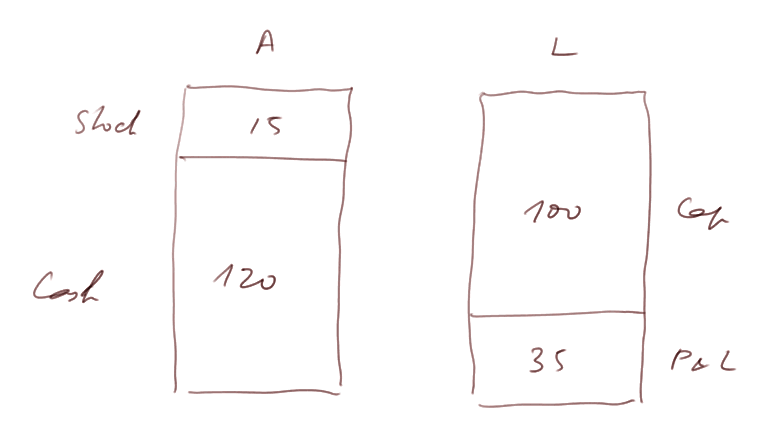
Transaction 5 : Acquisition of equipment (cash) 50 000 euros
- Posting : credit the Cash account 50, debit the Equipment account 50
- IS : still same as before, because transaction 5, like transaction 4,
doesn't affect the operations of the firm.
- BS
- Assets :
- Equipment : 50 (debit side)
- Closing stocks : 15
- Cash : 70
- Liabilities :
- Capital 100 (credit)
- Cumulated past retained earnings : 35 (credit, i.e. profit)
- Suppliers : 0

Transaction 6 : Sale of the remainder of our stock for 40 000 euros to Steve, and we grant
him a credit.
Note: we sold the second half of our stock for less than the first half (market prices fluctuate).
- Posting : credit the Sales account 40, debit the Clients account (Steve)
40
- IS (from the beginning of the firm) : again, we must do an inventory
- Sales 90
- Opening stocks 0
- Purchases 30 (debit)
- Closing stocks 0 (credit)
- Gross margin 60 (credit side)
- P&L : 60 (credit)
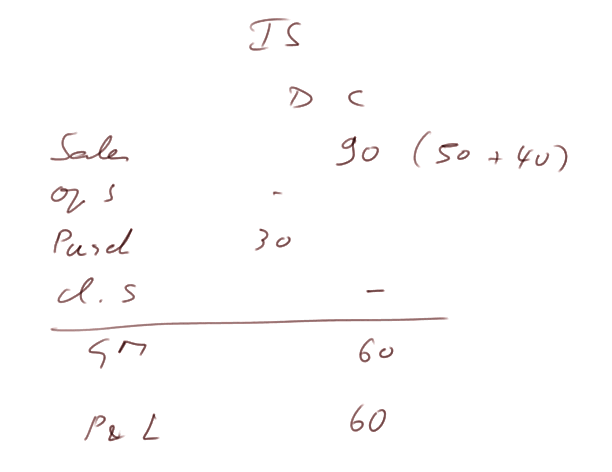
- BS
- Assets :
- Equipment 50
- Closing stocks : 0
- Receivables from clients (Steve) 40
- Cash : 70
- Liabilities :
- Capital 100 (credit)
- Cumulated past retained earnings : 60 (credit, i.e. profit)
- Suppliers : 0
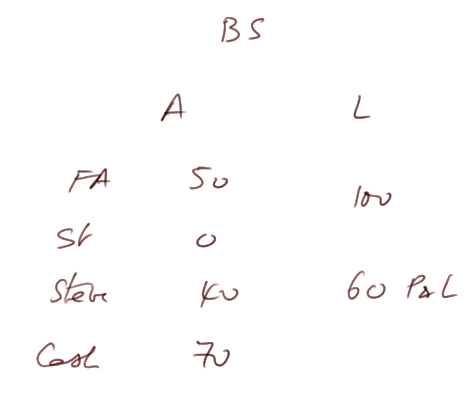
Transaction 7 : Purchase of goods for 50 000 euros.
(For a more elaborate example, where purchasing prices vary, see our accounting course with videos: https://lapasserelle.com/online_courses/accounting/complete_exercise/index.html. There we will be confronted with the problem of valueing stocks we just sold. FIFO method, LIFO method...)
- Posting : (we are not told how we paid ; we must know ; suppose it's cash)
credit the cash account 50, debit the purchases acc a further 50
- IS :
- Sales 90
- Op stock 0
- Purchases 80 (debit)
- Cl stock 50 (credit)
- Gross margin 60 (credit side)
- P&L : 60 (credit)
- BS
- Assets :
- Equipment 50
- Closing stocks : 50
- Receivables from clients (Steve) 40
- Cash : 20
- Liabilities :
- Capital 100 (credit)
- Cumulated past retained earnings : 60 (credit, i.e. profit)
- Suppliers : 0
Transaction 8 : Payment of salary 10 000 euros
- Posting : credit cash 10, debit salary account 10 (it's like "work entered
our firm", and of course it was "consumed" so it will be in the IS)
- IS
- Sales 90
- Op stock 0
- Purchases 80 (debit)
- Cl stock 50 (credit)
- Gross margin 60 (credit side)
- Salary 10 (debit)
- P&L : 50 (credit)
- BS
- Assets :
- Equipment 50
- Closing stocks : 50
- Receivables from clients (Steve) 40
- Cash : 10
- Liabilities :
- Capital 100 (credit)
- Cumulated past retained earnings : 50 (credit, i.e. profit)
- Suppliers : 0
These "final" IS and BS are not quite accurate : we haven't
adjusted them with depreciation and other possible adjustments. Let's now turn
to this, and establish more correct final documents.
To start with we establish the initial Trial balance :
| |
Debit |
Credit |
| Capital |
|
100 |
| Cash |
10 |
|
| Equipment |
50 |
|
| Mary |
|
- |
| Purchases |
80 |
|
| Salary |
10 |
|
| Sales |
|
90 |
| Steve |
40 |
|
| Total |
190 |
190 |
Let's include the stocks (after an inventory) :
| |
Debit |
Credit |
| Capital |
|
100 |
| Cash |
10 |
|
| Op stock (IS) |
- |
|
| Cl stocks (IS) |
|
50 |
| Cl stocks (BS) |
50 |
|
| Equipment |
50 |
|
| Mary |
|
- |
| Purchases |
80 |
|
| Salary |
10 |
|
| Sales |
|
90 |
| Steve |
40 |
|
| Total |
240 |
240 |
(Note : at the beginning of the next accounting period the closing
stocks (BS) will become the opening stocks (IS).)
Let's make two further adjustments.
Depreciation : Let's depreciate 1/5 of the equipment. We open two new
accounts :
- Depreciation in the IS : debit 10
- Cumulated depreciation in the BS : credit 10
- This cumulated account will remain in the future accounting periods TB,
while the "depreciation account of the period" (or "of the IS") will be set to
zero after "consumption accounts" are "extracted" from the TB.
Provision for doubtful client : suppose we are not sure of Steve ; we want to
depreciate half of his debt to us. We open two accounts :
- Provision in the IS : debit 20
- Cumulated provision in the BS : credit 20
Now we have a new TB ready to be transformed into an IS and a BS :
| |
Debit |
Credit |
| Capital |
|
100 |
| Cash |
10 |
|
| Op stocks (IS) |
- |
|
| Cl stocks (IS) |
|
50 |
| Cl stocks (BS) |
50 |
|
| Equipment |
50 |
|
| Mary |
|
- |
| Purchases |
80 |
|
| Salary |
10 |
|
| Sales |
|
90 |
| Steve |
40 |
|
| Dep (IS) |
10 |
|
| Cum dep (BS) |
|
10 |
| Prov (IS) |
20 |
|
| Cum prov (BS) |
|
20 |
| Total |
270 |
270 |
Next : we "extract" the consumption accounts of the period : they
are shown in green :
| |
Debit |
Credit |
| Capital |
|
100 |
| Cash |
10 |
|
| Op stocks (IS) |
- |
|
| Cl stocks (IS) |
|
50 |
| Cl stocks (BS) |
50 |
|
| Equipment |
50 |
|
| Mary |
|
- |
| Purchases |
80 |
|
| Salary |
10 |
|
| Sales |
|
90 |
| Steve |
40 |
|
| Dep (IS) |
10 |
|
| Cum dep (BS) |
|
10 |
| Prov (IS) |
20 |
|
| Cum prov (BS) |
|
20 |
| Total |
270 |
270 |
These seven accounts we "transfer" into an Income Statement :
| |
Debit |
Credit |
| Sales |
|
90 |
| Op stocks |
- |
|
| Purchases |
80 |
|
| Cl stocks (IS) |
|
50 |
| Salary |
10 |
|
| Dep (IS) |
10 |
|
| Prov (IS) |
20 |
|
| P&L |
|
20 |
All the seven consumption accounts (also called "revenue" accounts) are
replaced by only one.
We can, if we like show the last TB with this new unique P&L account :
| |
Debit |
Credit |
| Capital |
|
100 |
| Cash |
10 |
|
| Cl stocks (BS) |
50 |
|
| Equipment |
50 |
|
| Mary |
|
- |
| Steve |
40 |
|
| Cum dep (BS) |
|
10 |
| Cum prov (BS) |
|
20 |
| P&L |
|
20 |
| Total |
150 |
150 |
Now, this TB is the Balance sheet. It's only a matter of
presentation to put it in the conventional form.
Balance sheet (standard presentation)
Assets
| |
Debit |
Credit |
| Equipment |
50 |
|
| Cum dep |
|
10 |
| Cl stocks |
50 |
|
| Clients (Steve) |
40 |
|
| Cum provisions |
|
20 |
| Cash |
10 |
|
| Total |
150 |
30 |
Liabilities
| |
Debit |
Credit |
| Capital |
|
100 |
| Cum P&L |
|
20 |
| Suppliers (Mary) |
|
- |
| Total |
|
120 |
|







